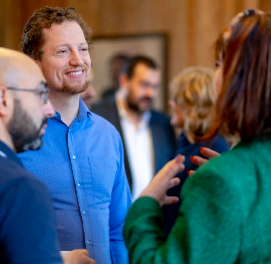Looking back – 20 years of leadership – what has changed?
By Christian Scholtes, Managing Partner TPCL Romania
Twenty years ago, the new millennium was still young. The Dot-com crash was just unfolding, 9/11 was an impossibility and Enron seemed to be thriving. A bunch of people had just agreed on a document called ‘The Agile Software Development Manifesto’. In the UK, Charles Brook was establishing The Performance Coach, which was to become TPC Leadership in the years to come. In less momentous news, yours truly was delivering his very first corporate training, on March 8 2001.
The world was anew, and full of promises. Yet, to put it in Peter Senge’s Systems Thinking framework, some of the deepest implicit assumptions influencing structures and behaviours in organisations were anything but new. Organisations were supposed to be run top-down, decisions were by far and large centralised, and senior management was to be treated with awe and wonder.
While thinking about teams and managers of days past, I’d like to invite you to go for a little experiment. Presuming that you were part of some corporate structure 20 years ago, please close your eyes and remember the image you had back then about how a leader should look like and should be like. Give it a few seconds…
Let’s see if your image and the description below are fairly aligned.
He (for in most cases the leader was a ‘he’) was a figure of strength, of great technical competence, and, ideally, of charisma. This was a person who was frequently ‘larger than life’, who, by their simple presence (and the occasional speech), made sure that the people they were leading were feeling motivated and energised to reach the ambitiously set targets. This leader knew exactly what’s going on and always came up with the right decision/ course of action. Working long, long hours, setting high expectations from themselves and others, pushing for ever increasing performance. In case of crisis, they were supposed to singlehandedly be able to turn the situation around and deliver the needed result.
Does it fit your image as well? Or is the image painted with too thick a brush? Perchance it does, perchance it doesn’t – in either case, I’d be happy to read your thoughts in the comments.
Getting back to the imagined profile and presuming that it does describe fairly well a certain leader, come to think of it, it really isn’t that new. The depicted image sounds less like the one of a normal human being, and rather like what we’ve always expected from a hero. Gilgamesh, Hercules, Roland… from immemorial times, the deeds and acts of valour of all these men have fuelled our imagination and have fed into our assumptions of what a leader is and forever shall be.
Until it turned out that actually it’s not working. Those hard-working and heroic leaders are not doing that well when it comes to delegation, people development, or work-life balance. They have great technical skills indeed, but when it comes to emotional intelligence and acting as a coach, these just don’t come to life, disregarding how many seminars they had to enrol in. They carry a lot on their broad shoulders, but there comes a time when the pace of change and the level of complexity is just too much for one single person, disregarding how much they’re pushing and punishing themselves and others for not doing enough.
This being said, to quote a famous movie, ‘life finds a way’. Perhaps the single most spectacular and impactful organisational change of the last two decades is the (in historical terms) sudden transformation of how we’re imagining leaders and what we’re expecting from them.
As of now, a new leadership model is generated by an environment where frequent and turbulent changes are the normality, where decisions need to be taken quickly by the people closest to the customer, and the new generations entering the work field need purpose and meaning in order to be truly motivated.
The leader is not supposed to be all-knowing any further; they’re however supposed to create psychologically safe systems and frameworks in which their agile teams find it easy to identify potential answers and test them quickly. The leader is therefore expected to act rather as an emotionally intelligent coach, who is able to provide the needed reflection environment where people (oh, those millennials and their need for purpose) can find both sense and sensibility in what they’re doing. Furthermore, while it’s obvious that great results will always be crucial, the very definition of results is dramatically changing, as we’re slowly but steadily shifting from shareholder to stakeholder capitalism; if the outcomes are not sustainable for the various ecosystems the organisation is part of, a temporary profit may prove excruciatingly expensive.
In other words, with all due respect for its glorious past, the heroic leadership model is somewhat passé. Hail the servant leader, for she is the one who may take us through the next leap of our development.
To continue the discussion don’t hesitate to get in touch.
@Copyright TPCL (2021)





